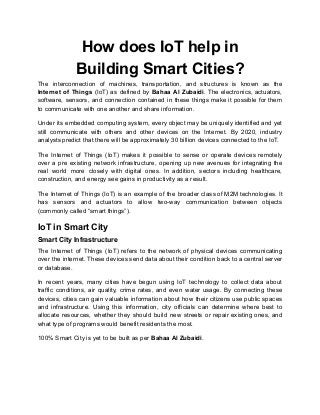
How does IoT help in building Smart Cities.pdf
- 1. How does IoT help in Building Smart Cities? The interconnection of machines, transportation, and structures is known as the Internet of Things (IoT) as defined by Bahaa Al Zubaidi. The electronics, actuators, software, sensors, and connection contained in these things make it possible for them to communicate with one another and share information. Under its embedded computing system, every object may be uniquely identified and yet still communicate with others and other devices on the Internet. By 2020, industry analysts predict that there will be approximately 30 billion devices connected to the IoT. The Internet of Things (IoT) makes it possible to sense or operate devices remotely over a pre existing network infrastructure, opening up new avenues for integrating the real world more closely with digital ones. In addition, sectors including healthcare, construction, and energy see gains in productivity as a result. The Internet of Things (IoT) is an example of the broader class of M2M technologies. It has sensors and actuators to allow two-way communication between objects (commonly called “smart things”). IoT in Smart City Smart City Infrastructure The Internet of Things (IoT) refers to the network of physical devices communicating over the internet. These devices send data about their condition back to a central server or database. In recent years, many cities have begun using IoT technology to collect data about traffic conditions, air quality, crime rates, and even water usage. By connecting these devices, cities can gain valuable information about how their citizens use public spaces and infrastructure. Using this information, city officials can determine where best to allocate resources, whether they should build new streets or repair existing ones, and what type of programs would benefit residents the most. 100% Smart City is yet to be built as per Bahaa Al Zubaidi.
- 2. Smart Transportation Systems The need for transportation systems to move people around increases as the population continues to grow. However, current transportation systems are not equipped to handle the increase in demand. There are already issues with overcrowding and congestion on roads, and adding more cars to the road only worsens matters. To combat this issue, some cities are implementing smart transportation systems. These systems rely heavily on IoT technology to monitor traffic patterns and adjust routes accordingly. They also connect vehicles and track vehicle performance, making it easier for drivers to avoid accidents and find empty parking spots. Smart Energy Management Smart energy management systems rely on IoT technology to monitor electricity consumption. Many homeowners already have smart meters installed in their homes, but these meters are limited to measuring total energy consumption. A smart meter can measure power consumption at different times throughout the day and provide a detailed breakdown of how much energy was used during peak and off-peak hours. This information can then be sent directly to utility companies to help them plan future projects and budget accordingly. If most households switched to smart meters, utilities could save billions while reducing pollution levels. Smart Water Management Many cities struggle with maintaining clean drinking water. As the population grows, more people require access to clean water. Unfortunately, many municipal water supplies lack sufficient capacity to meet the increasing demands. Some cities are turning to IoT technology to create smart water management systems to combat this problem. These systems use sensors to detect contaminants in the water supply and alert local authorities if dangerous contamination levels occur. They also use IoT technology to control water distribution to prevent water shortages. Smart Security Solutions Cities often struggle to keep their streets safe. Crime rates continue to rise, and many neighborhoods lack basic security features like streetlights and cameras. Some cities are incorporating IoT technology into their security systems to combat these problems. These systems use video surveillance cameras to record footage of suspicious activity and upload the videos to cloud storage servers.
- 3. When an incident occurs, police officers can view the recorded footage and respond immediately. Additionally, these systems allow police officers to remotely activate lights and sirens to catch suspects before they flee the scene. Thank you for your interest in Bahaa Al Zubaidi blogs. Please visit www.bahaaalzubaidi.com
